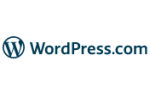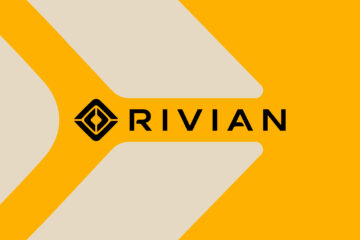Want to jump straight to the answer? The best website builder for most people is Wix, unless you’re trying to start a free online store, in which case you should use Square Online.
You can build a website that’s free forever. Zero prior experience? No problem. You’ll be done in a few hours or less.
Are there some drawbacks to not paying? Of course. However, with the best free website builders you can:
- Design your own site and make changes yourself
- Translate your site into multiple languages
- Let visitors sign up for email subscriptions
- Connect your social media accounts
- Sell products and collect payments from your own online store
To get a better sense of these products in action, we spoke with a number of people who are using these builders right now. They include business owners from a range of trades and industries, artists, freelancers, and others who are finding success online without spending a nickel on their site.
Keep reading to discover real-world insights into what each of these free website builders offers. After the reviews, you’ll find an in-depth guide to help you make sense of how we ranked the products and choose the right one for you.
The 5 Best Free Website Builders
We only looked at free forever website builders. No trial periods, no demos—just a website that is yours forever once you sign up.
If that sounds like what you need, here are your best options:
- Wix – Best for creating a polished site this evening
- Square Online – Best for building a free online store
- GoDaddy – Best for businesses that don’t need an online store
- Mozello – Best for building a multilingual site
- WordPress.com – Best for growing an audience with your site
One quick thing before we dive into the reviews. In this post, we’re talking about the completely free website builder from WordPress.com. So, when you hear us talking about the lack of customizability in WordPress, we’re distinctly talking about WordPress.com, not WordPress.org. It’s a little confusing, which is why I wrote a post about WordPress.com vs WordPress.org.
We use WordPress.org here at Quick Sprout and it’s amazing, but you have to pay for hosting. So, it’s not truly free. You can do a ton more with a paid WordPress.com plan as well, but that’s not within the scope of this review.
#1 – Wix – Best for Creating a Polished Site This Evening
- Great for websites of all stripes
- Easy-to-learn visual editor
- Incredible customizations
- Over 500 templates
Overall Score: 4.13
Accessibility For Beginners: 4.75
Ability to make it your own: 4.5
Quality of free features and services: 3.5
Unobtrusiveness of advertisements: 3.75

Wix has the easiest website builder ever invented according to the folks we interviewed. What’s more is that you have a ton of freedom to customize—the straightforward design experience doesn’t take away from the finished website.
Normally, you get an easy web building experience on more limited platforms. Wix has successfully threaded the needle and put forward a free website builder that allows for a ton of artistic freedom while remaining stupid simple to use.
Taking a quick look at the nuts and bolts, Wix comes with the standard array of hosting and site building resources:
- 500 MB bandwidth
- 500 MB storage
- Galleries, slideshows, vector art, videos, and more
- 500+ customizable templates
- 24/7 customer support
- Blogs
- Messaging
- Site analytics
- CDN enabled
That’s not a typo in point four. There are more than 500 templates you can start using right away.
Search for something that calls out to you or find one of their pre-built solutions for a particular vertical. There are a lot:
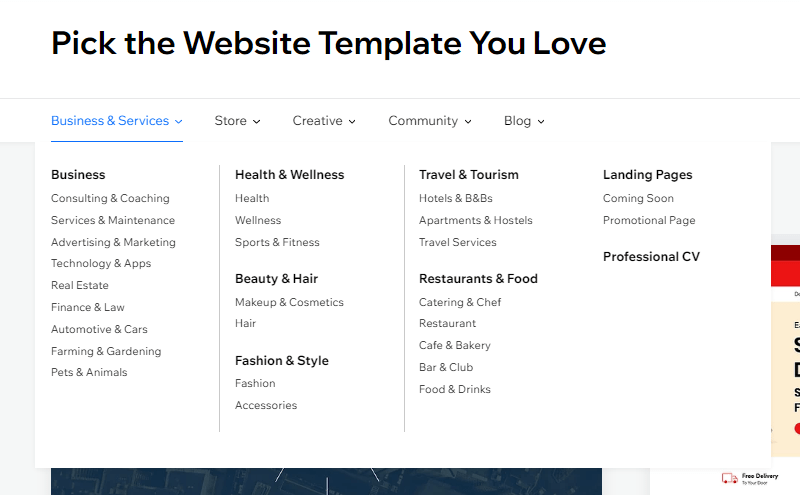
And that is just within the “Business and Services” category. With Mozello, there are 48 templates, which is handy, but certainly not the range you get with Wix. WordPress offers just 23.
There’s a wide variety in Wix templates, too. Here’s a quick sample of some of the templates cafes and bakeries can start off with:
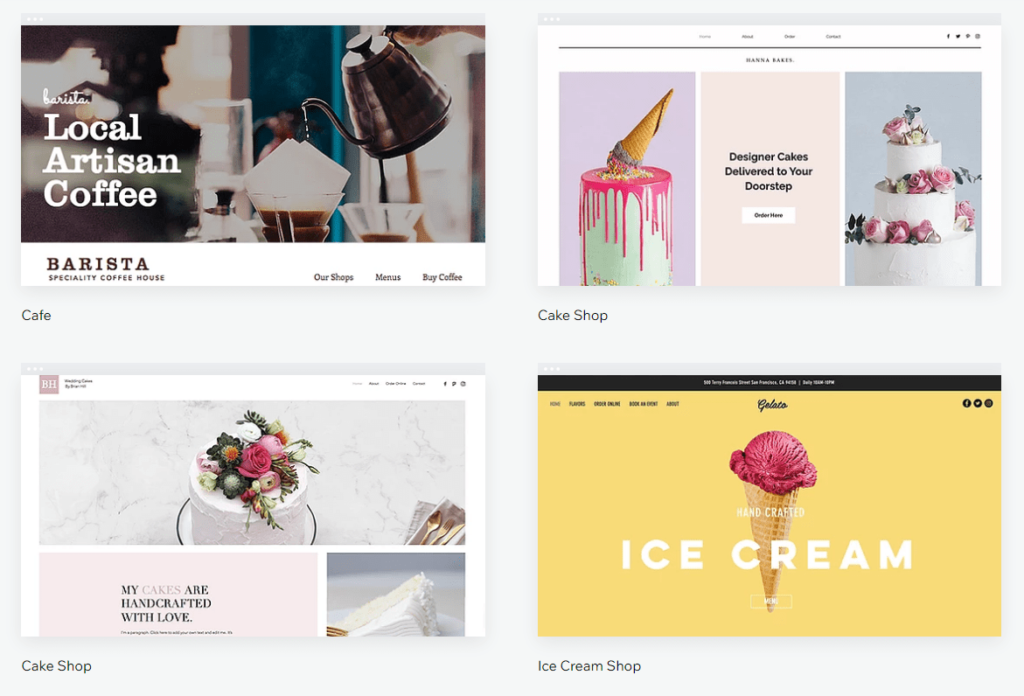
Once you start putting in your own content, it’s not long before you have a viable site that looks spectacular.
If you see something you like, you can start editing the template right on the Wix site. You have to create an account, but it’s free and you can switch templates as many times as you like.
Wix wants you to play with their website builder because it offers so much more freedom than the others. In terms of making it your own, you won’t be limited in terms of colors, fonts, layout styles, and your ability to tweak virtually every aspect.
“It is very customizable with the gadgets you can add,” one animator told us about Wix, “so it can have a more personal branding than standardized/mainstream.”
She needed a portfolio that stood out from the crowd and conveyed her affinity for design, and used her Wix site to get more work as a freelance animator.
The users we surveyed gave it the highest ratings for accessibility and ability to make it your own.
This is very impressive.
What I’ve seen elsewhere is that the platforms with more limited design capabilities wind up being a lot easier to use and vice versa. Wix shattered those expectations and scored extremely high in both these categories by successfully balancing a freedom to design with ease of use.
A game designer, who uses both WordPress and Wix, said that you can’t do a better job than Wix at making the builder easy to use. Yes, there are more buttons and options than WordPress, he said, “but if you’re remotely creative, Wix is definitely a dream come true.”
With free versions of GoDaddy, Mozello, Square, and WordPress, you’re much more confined to the template. With Wix you can line up things the way you want and it’s not a struggle.
“Wix opens the door,” said the game designer, “because you can move elements all over the page, wherever you want them.”
Wix comes with a lot of guidance for all the tools at your disposal. It’s not like graphic design gurus are the only ones taking advantage of the freedom.
An artist who sells mosaics told us that she’d never build a site until she used Wix. She was daunted by the task and put it off for several years before she “finally broke down” and just made the site.
It turned out to be super easy because she went with Wix.
She credited the search bar in the website builder with making her initial build much easier. When she ran into an issue, it was easy to find help.
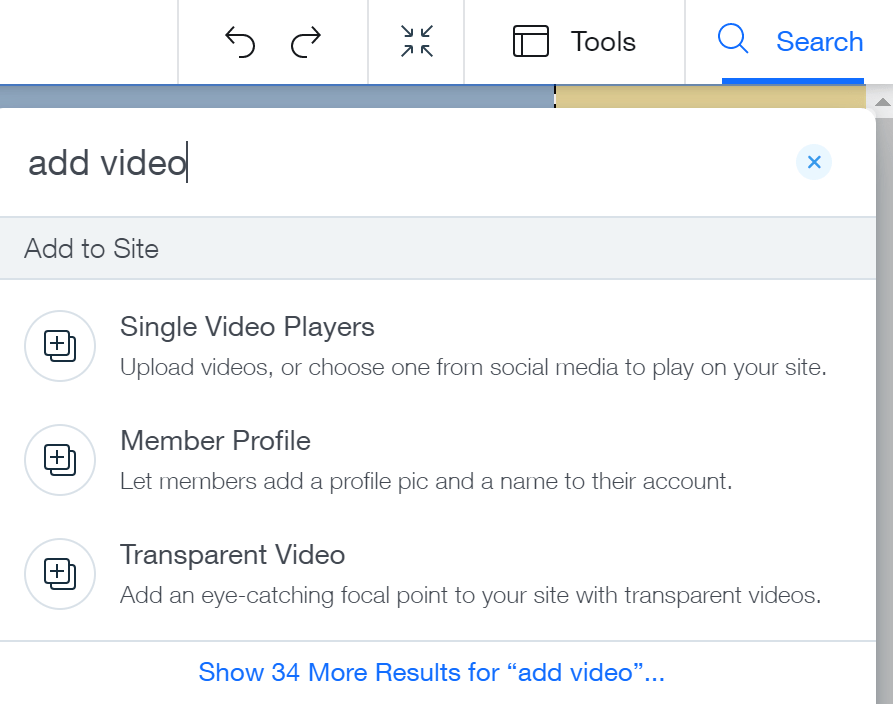
The search bar is connected to Wix Help Center’s database, which contains answers to thousands of questions beginners have asked as they try to build their site. You’re certainly not on your own.
There were times where she encountered unfamiliar terminology but, the mosaic artist noted, “for the most part, I was able to use it to figure out how I wanted to set things up.”
Wix is not without its drawbacks, however, and it scored lower in terms of the quality of free features included with the website builder. The advertisements and upsells also made a negative impression on some users.
Let’s take a closer look.
Building a Free Website with Wix
Just how quickly can a total beginner launch a site with Wix?
One of the users I spoke with, a barber, found out she was going to lose the website she’d been using to book appointments. Her shop is in a co-space, and the building owners told everyone the night before the site went down.
“I was able to build my new site on Wix the same day I was told I was going to lose my old one,” she said.
There was no downtime, no period of time where people couldn’t book appointments. She’d never built a website before, so “it was nice to have something that was done and accessible to my clients.”
Bear in mind that things like booking appointments are a paid feature with Wix. You can do this free with Square Online (so long as you use Square to process payments), and all the barber did in this case was build a Wix site with a link to their Square appointment booking. She liked the way Wix sites looked a lot more than the potential builds on Square Online.
The freelance animator I spoke with did the same thing—built their site with Wix and linked to Square. Sure, you can just build a site on Square, but Wix gives you much, much more design flexibility.
As the designer I spoke with noted, “Wix works quite nicely because it provides all the necessary image and video features for designers and artists.”
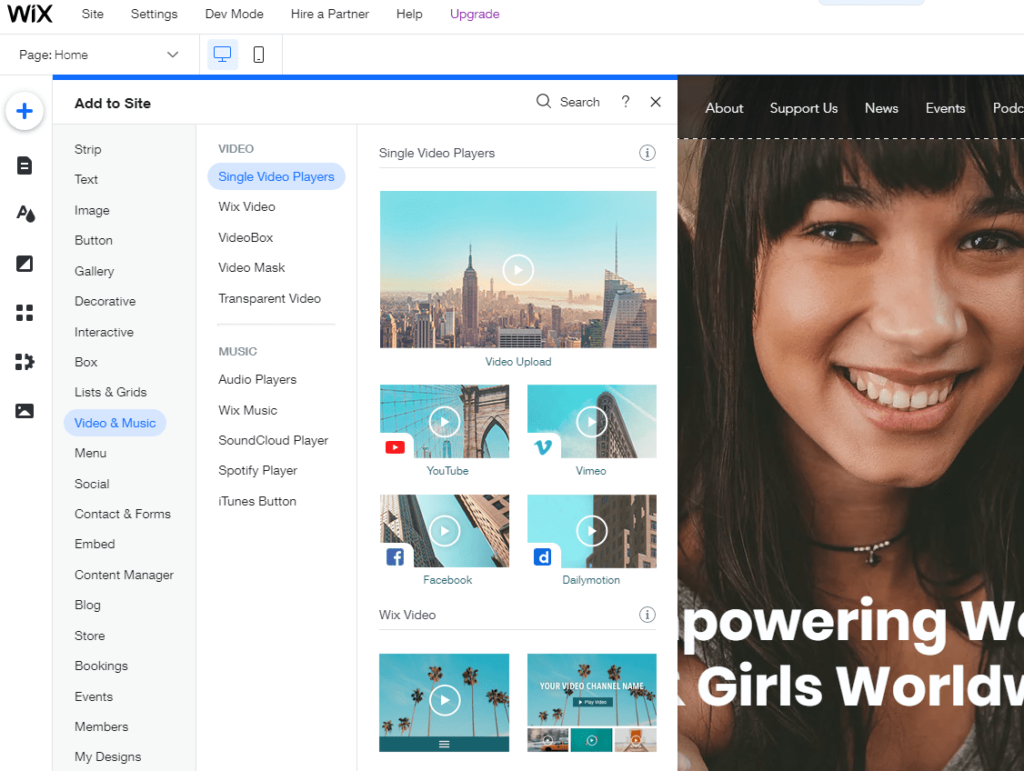
It’s not that you can’t build a portfolio on Square, but Wix is going to let you personalize the layout a lot more.
The animator, as you might expect, needed video to showcase her work. Not only was it easy to add videos, but Wix “allows the image to be shown at various resolutions to be compatible with website speed.”
If you’re new to the web design game, the idea of showing videos at various resolutions may be unfamiliar, but it’s important.
As the animator noted, this can help with your website load time. A high-resolution video on free web hosting might slow your site down. But you also have to think about storage limits. The ability to play with resolution means you can avoid maxing out the 500 MB of storage Wix gives you for free.
You can even control the way the video appears on your site. Choose from 14 different animations to have the video fade in, fold-in, slide-in, and more:
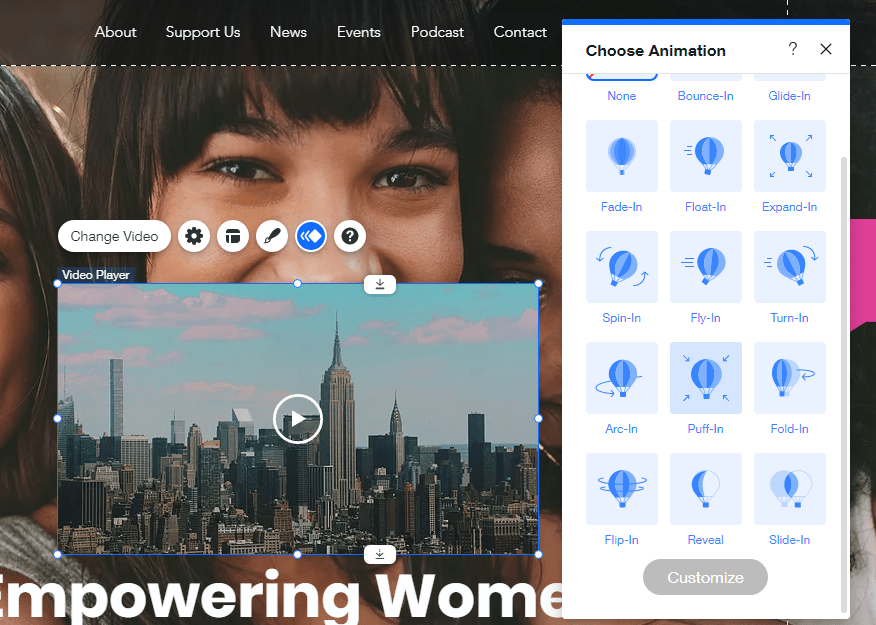
You might not believe me, but we are really just scratching the surface of what you can do with Wix. I could spend pages talking about your design options, but there’s a lot more than just nifty animations to help you build a site.
The barber also really appreciated the free site analytics. You can get deeper data with premium subscriptions, but she noted that even with the free version, “it shows me who, where, when people are looking at my website, how many live visitors I have, where in the surrounding areas people are looking at my barbershop.”
This happens with zero work on her part—the information is all right there when she signs into her Wix account on her phone, which is how she prefers to manage her site though she built it on a laptop. “It’s interesting to see where Google, Wix, Facebook, and Instagram are taking us,” she said.
Usually freemium services are withholding the good stuff. With Wix, you get a really solid version of the website builder. It’s not Editor X, the Wix advanced website building platform, sure. Wix sites “have to assume a certain layout,” one user told me. But you’re definitely less limited than other sites, especially within the free website category.
Wix isn’t saving the best design features for paid users. One user told us how she upgraded to premium Wix just to use her own domain, but kept her website design the same.
Cons of Building a Free Website with Wix
For most users we talked with, the drawback with Wix isn’t limitations—it’s what they try to push on you.
“It just feels like they’re constantly trying to upsell you,” one user said. There are a lot of notifications, emails, and “special” offers.
This is hardly unique to Wix in the free website builder space. Like GoDaddy, they have a range of additional online services that they want you to start spending money on.
“I don’t appreciate that,” said one user, talking about the consistent stream of offers. “They’re like, ‘You should have your own email through your website.’ And I’m like, ‘I can just use my Gmail.’” In order to keep Wix a free experience, you’re going to have to ignore a lot of offers.
Other users encountered sort of the opposite problem, where they didn’t realize they were using paid features to design their site. Certain Wix templates are assuming you’re going to use paid features. If you choose a template with booking features, for instance, it’s going to try to make you use Wix’s appointment booking, which is a paid service.
This is what happened to the barber, who chose a template she liked, “and it became frustrating because I’d put a lot of work into the template and I thought I was going to have to start over in order to set up bookings without having to use a paid version of Wix.”
In the end, she was able to link to Square without starting over. “I wouldn’t say it was hard,” she noted,” it just wasn’t user-friendly to get the baked-in upsells out.”
If you are trying to sell products or book appointments for free, you’re better off going with Square Online. That’s what it’s meant to do. You may be able to stretch Wix functionality with workarounds like the barber did, but Square Online is pre-built for just that.
In terms of advertisements on your free site, Wix inserts a small footer that says “Proudly created with Wix.com” and runs a thin banner ad at the top of your site:

Wix does not run third-party advertisements of any kind on your site.
Some users were less annoyed by the Wix advertisements on their site.
“It’s like hashtagging,” said the barber, who routinely tags the vendors she works with. “If I’m using clippers from such and such a manufacturer, I’m happy to give them a shoutout, and it’s kind of the same thing with Wix.”
In her view, the ads were more than worth it to avoid paying for hosting, she said, “though I could see how it would bother some people.”
Upsells and advertisements are kind of a given in the freemium space. If that kind of thing bothers you, I recommend Square Online or Mozello, who got perfect scores for lack of ads. All they have is a discrete footer that blends into your site.
One more potential issue users could run into—though we didn’t run into any users who mentioned it explicitly—is the combination of really cool features and limited storage. 500 GB is pretty standard in the free website world, but most other platforms don’t let you do as much with your site.
This is just something to be aware of. Wix doesn’t tell you how much storage you’ve used or how much you have left. You don’t want to craft this amazing site with lots of visual content only to suddenly need to upgrade your site due to hitting storage limits.
The other major thing that seemed to bother users was the web address. When you sign up for a free site with Wix, your URL is:
- accountname.wixsite.com/yourbusiness
Compare this to Square, which is:
- yourbusiness.square.site
With Wix, your account name and your business name are both part of the URL. For one user I talked with, this ended up being way too long and repetitive because her account name and business name were the same.
With Square, it’s just your business name plus “square.site”.
It’s always better to have your own domain (which is why it costs money). But if you have to use a free domain name, the one you get with Wix is longer compared to some of the others.
This is going to be harder for people to remember, and it’s not going to look so sharp on any marketing materials you share.
One user described the free Wix URL as “wonky”—which feels apt—and she decided to upgrade to get a web address “that was a little less cumbersome.”
Why We Ranked Wix at #1
Wix had the highest score for accessibility and tied for the highest in terms of giving people the ability to make their website their own. Where it received lower scores were in the quality of free features included beyond the website builder and the ads. You can’t take payments online, for example, and you will constantly be prodded to upgrade your plan.
We put Wix at number one because it won what we considered the two most important categories by successfully balancing ease-of-use with freedom to create. The vast majority of users are going to have no issues with this tool, and they’re going to be able to make a site they like.
Wix did not have the highest overall total score—that went to Square Online, which is phenomenal for online stores. For users that need ecommerce, Square is the clear winner,
But when you step back to consider general purpose website builders, Square definitely loses out to Wix. You can’t really step outside the template and it’s going to take some inventive work to keep your site from looking like a simple shopping cart. That’s fine if your online store is the focus, but if it’s not, a tool like Wix is going to serve you better.
Bottom line: Wix is the best place to start if you need a free website that you can manage yourself.
#2 – Square Online – Best For Building a Free Online Store
- Site builder from the top payment processor
- Sell products online for free
- Easy to add products and edit inventory
- Clean, functional templates
Overall Score: 4.63
Accessibility For Beginners: 4.67
Ability to make it your own: 3.5
Quality of free features and services: 4.33
Unobtrusiveness of advertisements: 5

Square Online is the best way to start selling products online for free. Whether you’re an artist striking out on your own, a restaurant that wants to start curbside pickup, or an established business looking for a digital storefront, Square is going to work better than any other free option.
Other platforms will push you to upgrade to a premium membership to get ecommerce features, whereas Square Online includes absolutely everything you need to make your first sale and beyond:
- 500 MB storage
- Unlimited bandwidth
- Accept payments from credit cards, PayPal, Apple Pay, and Google Pay,
- Sell unlimited products, services, events, or donations
- Coupons and gift cards
- Inventory management tools
- Square analytics
For many years, we recommended Weebly as the best way to build an online store for free. It still is—Square just owns Weebly now. If you use Square Online, you’re using Weebly’s interface to build your site.
You can still build a web store on Weebly, but you’ll only be able to sell a limited number of products, which is why we recommend Square Online for ecommerce instead.
For business owners, this is a best-of-both-worlds situation. Square is a phenomenal POS system, which allows companies to take payments online or in person. Square sites, by themselves, were fairly primitive.
But now that you have Weebly as your website builder, you can create a much more attractive website for your online store.
“I think it is much easier to use than all the other supposedly out-of-the-box services,” said the owner of a microbrewery who uses Square. “It’s pretty basic point-and-click,” he said, and “probably has the highest bang for your buck visually as long as you can provide it with images and a well-branded logo.”
You won’t have quite as much freedom to design as Wix or GoDaddy, which explains the slightly lower rating on your ability to make it your own. But it’s incredibly simple to create a functional online store.
“You basically just drag and drop modules onto a wireframe, upload images, write text, and rearrange things as necessary,” said an artist who uses Square Online to sell clothing and home goods. “If you are looking for a simple, clean site design and an easy-to-manage backend system, it’s a great service.”
You’re just clicking around, selecting the elements you want from clear options. Because it’s built specifically for online stores, you’re not fighting with the platform to get a working layout.
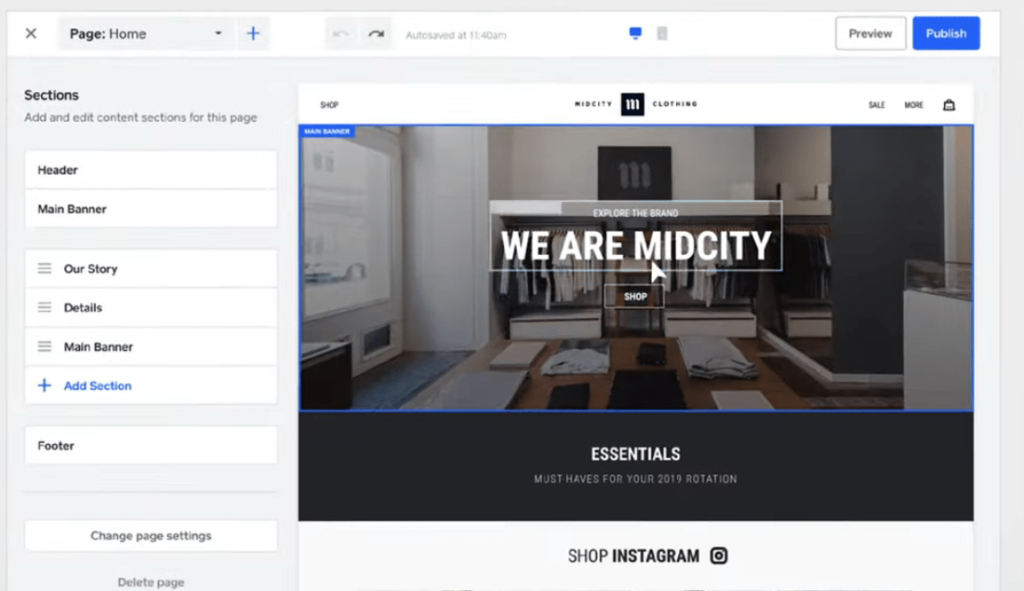
And it’s actually free. GoDaddy lets you build an online store for free, but you have to pay in order to start accepting payments and fulfilling orders. With Wix and WordPress, you need a premium subscription to sell. Mozello has a five-item limit with the free version, which makes it a nice perk rather than a viable online store for most businesses.
With Square, you can sell an unlimited number of items with the free plan. You’re not trying to navigate upsells or work around annoying limits.
While there is no charge to use Square Online, like any payment processor they take a percentage of each transaction (2.9% + 30¢). This is just about as low a rate as you are going to find for any online store payment method, and Square Online does not charge a monthly fee.
As the owner of the microbrewery explained, “I use Square to sell on in our taproom and I use their online sales, so they’re getting their cut another way.” This wasn’t a huge downside, though, as you are always going to get charged for using any payment processor.
And, with Square, his online and taproom sales are all connected. This makes it a lot easier for him to manage the books and keep track of inventory.
With Square Online, you’re getting an online store for free and automated bookkeeping and reporting. That’s not too shabby!
The artist who used Square Online echoed the brewer’s sentiments.
“The major selling point for me,” she told us, “is the integration with Square’s other seller services on squareup.com where you can check analytics and print out sales reports.” This is a free, turnkey service from Square.
“I like that data from both my in-person sales and my online sales are synced up to the same place,” she added. You don’t have to do anything beyond accepting payments in order for Square to provide clear information about customer trends and behaviors.
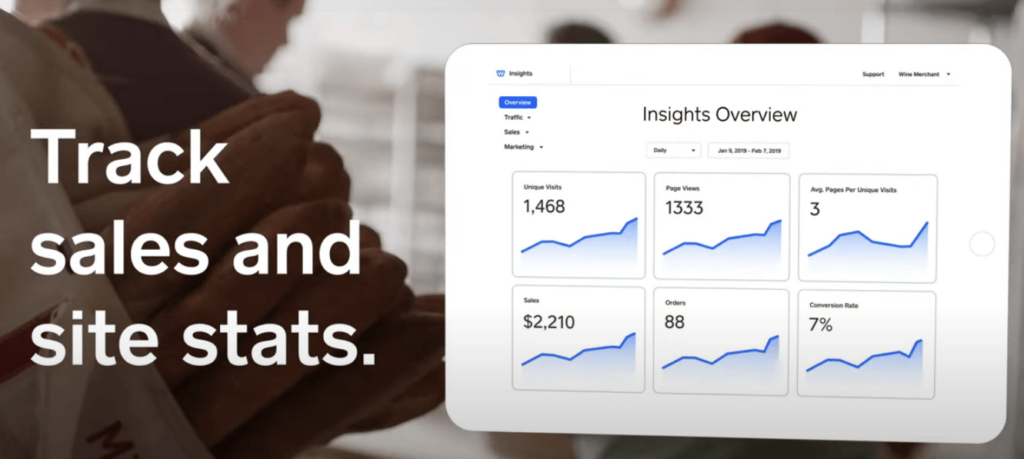
One thing that jumped out at us was Square’s perfect rating for unobtrusiveness of advertisements. You get “square.site” in your web address, and there is a small “Powered by Square” message in the footer.

It’s not much less than other sites, but because Square is a well-known payment processor, having their branding on the website isn’t necessarily a negative for online stores.
We spoke with a baker who used Square Online, and she was happy to have the branding of a reputable payment processor on her site.
“Most people are familiar with Square,” she said, which makes people more comfortable entering their credit card information.
Yes, your website is going to do free advertising for Square, but there are no banner ads and their branding leaves a limited footprint that won’t scare away customers.
Building a Free Website with Square Online
The upshot to having Square host your website is that it’s in their best interest to help you sell as much stuff as possible. The more people buy, the greater the number of transaction fees Square gets.
So, it should come as no surprise that they’ve made it incredibly easy for anyone to set up an online store.
Compared to a simple site, getting all the correct information about your products into a good-looking, shoppable website requires a little more effort and upkeep. None of the users I talked to mentioned any problems getting things the way they wanted.
It might seem like a tall order for a total beginner to start selling an unlimited number of products, but Square has made it so easy. You’re still just pointing and clicking to add images, product variations, prices, sales, SKUs, weights, and more.
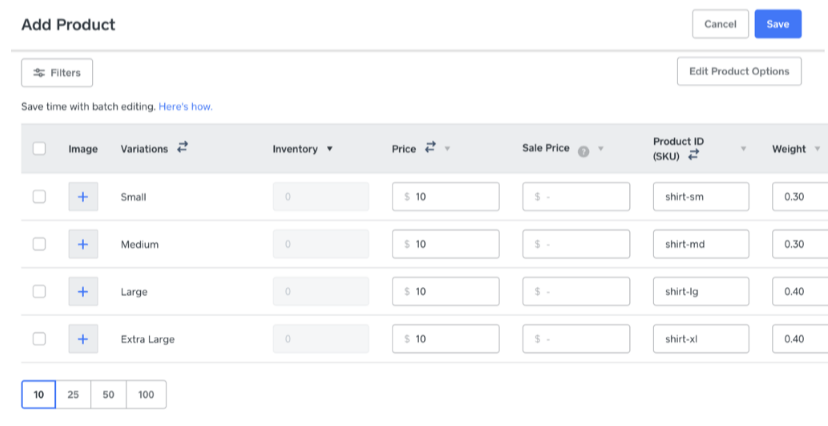
Every sale is tracked and your inventory is always up-to-date, whether people are purchasing online or swiping their card through your Square reader. There are a lot of moving parts on an ecommerce website, and Square Online makes it as easy as possible to stay on top of them.
The simplicity of the builder, which is great for putting together an online store quickly, comes at a cost to your ability to customize the look and feel.
“Its basic plan can be limiting at times,” the artist told me, “so I’ve had to be pretty creative with my graphics to try and make it work.”
It is really geared towards online stores only. The builder isn’t truly drag-and-drop. Instead, there are sections you can customize. You get a solid range of fonts and colors, but you aren’t dragging things wherever you want.
People looking for a unique site design may be turned off by how templated it is. But for a free online store, you can’t beat it.
As the brewer said, “You can argue about the customizability of Square, but honestly, it’s a really clean system.”
Simply, it just works.
Even the artist who struggled to make her creative vision work with Square loved the convenience.
“The nice thing about having my payment processor also handle my online store is that my inventory is synced,” she said. Whether she sells online or at an art show, “I don’t have to worry about recounting and restocking two separate storefronts.”
And that is the heart of the value with Square Online’s website builder. You don’t have to think about the backend of your online store at all. You have to come up with product descriptions and take good pictures. Other than that, you are just pointing and shooting.
If the website builder feels a little templated, most of the users seemed fine with the tradeoff because everything just worked. In the land of free websites, having a fully-functional online store outweighed the benefits of a snazzy design.
Cons of Building a Free Website with Square Online
This may not come as a surprise, but you have to use Square as a payment processor to have the streamlined experience with your online store I’ve been describing. If you’re an established business that already has a relationship with another payment processor, it might be worth checking out another site builder.
Just pay attention to the processing rates, as Square’s are quite low. You might be able to pay less on processing, nothing for a website, and get all the built-in analytics by switching to Square.
The free version doesn’t give you every ecommerce feature offered by Square. For the brewer, it was no big deal, but the artist had some trouble setting up her shipping rates.
“On the free plan you can only set flat rates for specific combinations of item weights and shipping destinations, with no option for calculated shipping,” she explained. “Figuring out the best way to arrange shipping rates to accurately reflect what I’d be paying at the post office was tricky.”
Premium Square plans come with this feature, which saves a lot of time and energy for folks with customers across the country and around the world.
None of the Square users we talked to encountered problems with storage limitations, even though they all had a lot of images on their sites.
You only get 500 MB of storage with the free plan, which could be an issue if you are uploading lots of high resolution images of your products. That amount of storage is par for the course when it comes to free website builders, but it’s something to be aware of.
The brewer thought it was important for people to know that customer service was not that great.
The other users didn’t mention it being good or bad, but he had run into some trouble when he started selling lifetime memberships. This was in violation of Square’s terms and conditions, and they cancelled his service. “Ultimately, it’s my fault,” he said. “I didn’t read the terms of agreement as deeply as I should’ve.”
This is something you should be aware of with any product you sign up for—even the free ones—but I think it’s especially important when using something like a Square Online web store, where you’re going to have a lot of revenue on the line.
The last core issue that people had is one we’ve already covered. You can’t really control the layout with Square once you commit to the template you’re using.
“If you’re looking to have a more interactive or asymmetric site design,” said the artist,” you’ll have to upgrade plans to write your own custom code.”
You’re also not going to be able to run a blog. You can make posts on your website that folks can share, but there’s no turnkey blogging feature that lets people comment on posts like you see with the other builders.
The tradeoff here is sacrificing a little bit of personalization to get an online store. Wix will give you more freedom to design a website, but you have to start paying per month if you want to sell online.
Why We Ranked Square Online at #2
Square received the highest total score based on our research, but it’s not number one simply because it works fantastically only for online stores. For people who want that, it’s the best, but it struggles to hold its own in terms of general website creation. If this were a review of free ecommerce platforms, I’d put Square at number one.
And, perhaps Square will eclipse Wix by the next time we review. The graphic designer’s two biggest complaints were the limited number of site layouts and an inability to edit multiple elements with one motion. But they followed that up by saying that Square has made improvements in both regards over the past few years.
And it’s true. If you look at Square sites put together a few years ago and compare them to more recent builds, the difference is stark.
GoDaddy is another great general purpose website builder, but we put Square ahead of it because Square offers such an amazing online store.
As the brewer said, “For someone who doesn’t have every hour in their life to dedicate to building their website and fixing it all the time, I think it’s the perfect solution.” I agree wholeheartedly.
Bottom line: There is no better way to launch and grow a free online store than Square.
#3 – GoDaddy – Best For Businesses that Don’t Need an Online Store
- Versatile site builder
- Great for business pages
- Great capability for customization
- Virtually no learning curve
Total Score: 4.56
Accessibility For Beginners: 4.25
Ability to make it your own: 4.5
Quality of free features and services: 4.5
Unobtrusiveness of advertisements: 4.5

GoDaddy is a company that offers the full range of online services for business. Their free website builder is a great place to start for many. It has the best all-around scores of the products we reviewed and that’s a great way to think about what it can do for you.
You can’t create an online store for free, but not every business needs that. And GoDaddy gives you many more design tools than Square Online to get your site on-brand and on-message, such as:
- Upload 250 images
- Galleries, slideshows, and videos
- Blogs
- 24/7 Customer support
- Email and social marketing tools
- Messaging
- Pop ups
People really loved all the professional touches that were easy to add, like banners, pop ups, and messaging. Whenever customers arrive at the page, they can click the messaging button in the corner to leave a question.
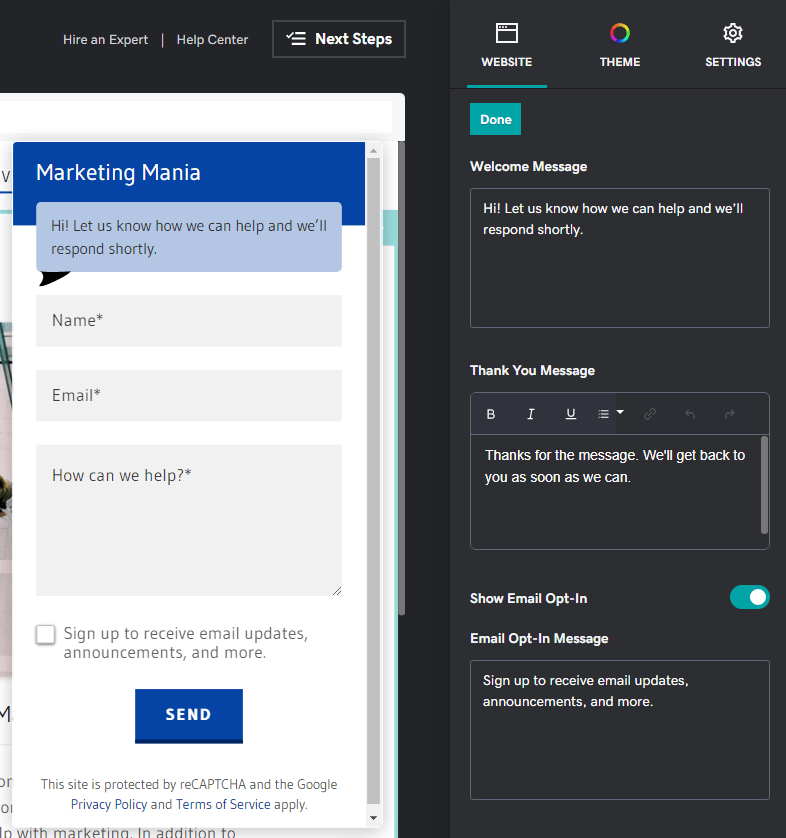
Customers have the option to leave messages or subscribe to email announcements. You can get contact forms with pretty much any free website, but the messaging button is pretty sleek. It makes your site look more legitimate, to say nothing of the value of collecting information from site visitors.
As you can see from the screenshot, adding features like this is straightforward. Type the welcome message you want and add an email opt-in with its own message, if you’d like.
“As long as someone knows how to navigate basic computer and web functions,” one user told us, “then they should be competent enough to navigate GoDaddy’s menus and widgets.”
People loved the customizability and how easy it was to work with. As one of the most recognizable names, a lot of people come to GoDaddy first, and the website builder has been stress-tested a lot. It’s beginner-facing and very friendly to small business owners.
We talked with a woodworker who used GoDaddy to book new jobs and showcase furniture he’d built. He loved how easy it was to create a good-looking website.
“If the business creator has a name, purpose, and idea for their company, it will display well,” he said. He’s not exaggerating.
When you sign up, GoDaddy asks you a few questions about your business and starts populating a template that will work well. You can choose another template to jump into and start working, or follow the “Next Steps” identified by the website builder:
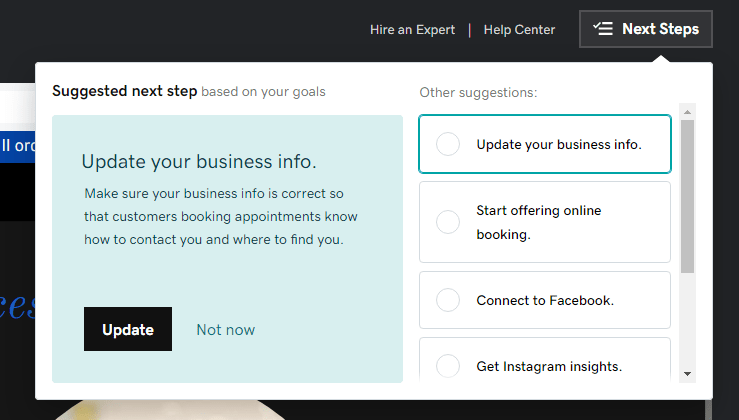
No matter where you are at in the process of building your site, GoDaddy will identify things you can do to make sure it looks good online.
GoDaddy users rated it highly for accessibility, though not as high as your other options. Square and Mozello are a little easier for beginners, but you can’t do nearly as much as you can with GoDaddy.
“Your options aren’t limited, and that’s what I really like,” said a user with a website for her dance academy. She really appreciated the ability to “go in and make it work for whatever we’re doing.”
She wasn’t alone in that opinion. Another user wrote that, “I’ve read no instructions but still created what I feel is a great site.” I think that sums up the website building experience with GoDaddy very well, but let’s dive a little deeper into the platform.
Building a Free Website with GoDaddy
GoDaddy is not a total freeform builder. You can’t drag elements all over the page as you can with Wix. That said, it gives you a lot of different types of sections to add, such as logos, schedules, audio, video, galleries, and slide shows.
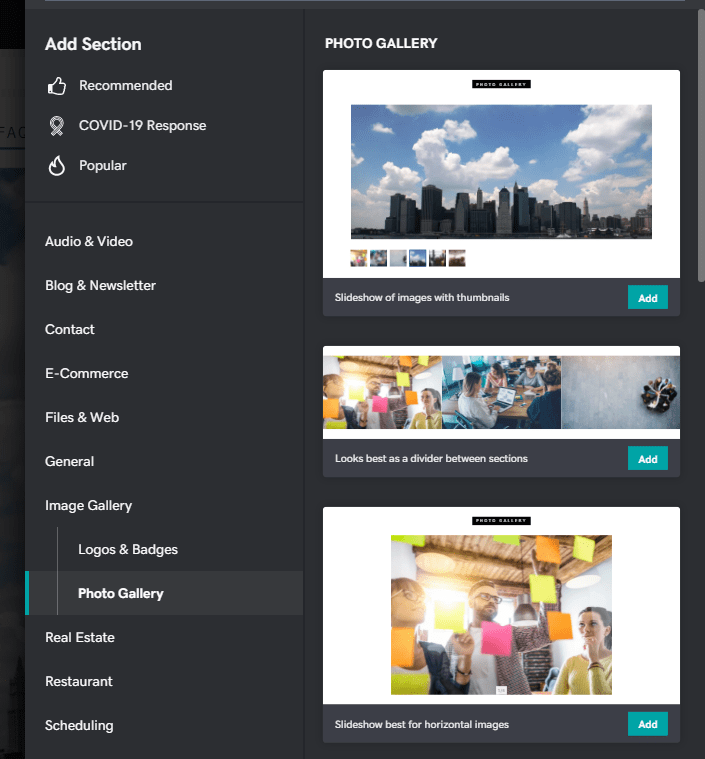
Adding these features is not difficult at all. The dance instructor knew she wanted a slideshow to be the first thing her visitors would see. “At first I was like, oh gosh, because I knew that’s something I wanted to go there,” she said, but she was worried it would be hard to create.
With GoDaddy, though, it was as simple as it could be. She just selected the slideshow option, added images, and it was done.
Keeping it current is no problem either. “Obviously this year, I’m going to want to change it up,” she said. “And that’s super easy for me to do.”
She also really benefited from the pop up feature. “I like that you can add that whenever we are in the process of registering kids,” she said. As soon as parents log onto the site, “they get this notification to ‘Register Now’ before they can see anything else.”
Making the enrollment process as easy as possible for parents is critical for her business. GoDaddy lets her customize popups with a few clicks. And when the registration period is over, it’s just as simple to remove.
The tools you get aren’t as robust as the paid plans. For example, you can only connect a single social media platform to your website, whereas premium plans let you connect far more. Still, every user I interviewed made use of connecting Facebook or Instagram to grow their audience.
The baker wished that the premium SEO tools were included with the free version, but did note that “there is a small section in settings for SEO where I can add keywords, etc., so it’s not completely [lacking].”
This is good for the very basics, but most of the good tools to improve your SEO ranking require upgrading. Same goes for the marketing tools where you’re getting a limited selection. That said, none of the other platforms are giving away anything better for free.
All in all, there were very few complaints about GoDaddy’s free website builder and a lot of positives. “It’s a really good option because it’s so easy to figure it out,” said the dance instructor, who had never built a site before.
Cons of Building a Free Website with GoDaddy
The users we surveyed gave GoDaddy very high marks for ease of use and the ability to customize. That said, more than one reported difficulties trying to get their site to align with the vision in their head.
This was a big reason why we ended up ranking Wix higher, despite it getting a lower average user rating—Wix really lets you customize the layout, whereas GoDaddy has much more of a traditional rigid template:
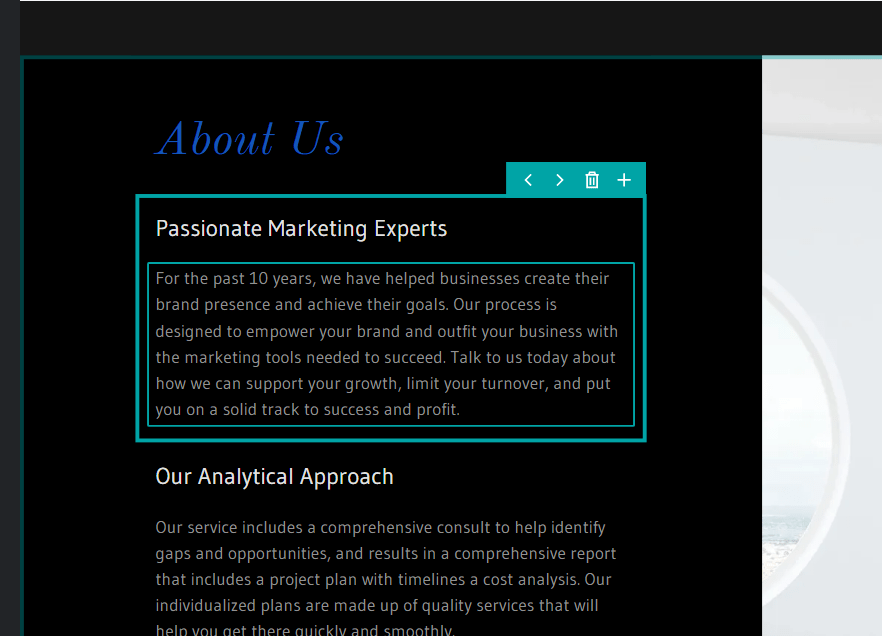
Yes, you can add many more different types of sections and features than Mozello or Square Online, but you can’t really color outside the lines.
Sometimes you have to settle. The dance instructor ran into trouble trying to get her staff page to look the way she wanted. She had to “find an easier way” to do it that wasn’t entirely what she wanted. It ended up working fine, but it wasn’t like she could do exactly what she wanted with ease.
People did not seem to mind the header and footer ads for GoDaddy on their website. A baker who uses GoDaddy for her dessert business described the ads as “small, with a very minimal impact.”
It was more the advertising directly to the users that bothered them. Because GoDaddy offers virtually everything a business needs, you’re definitely going to be hit by upsells for email, advanced SEO tools, better hosting, and so on.
With the free version, for example, you can only connect a single social media account, which is then synced with your control panel for GoDaddy. If you are using more than one social media platform, GoDaddy is going to encourage you to upgrade to centralize all of your social media accounts.
“We’ve found it’s just easier to ignore the prompts to connect our social media accounts and just use them on their individual platforms,” said one user who maintains the website for a dog grooming business, “rather than jump through the hoops for the slight privilege of accessing them all in one place.”
These types of upsells are hardly unique to GoDaddy, but the actual pricing is not always 100 percent transparent.
The carpenter said that “GoDaddy lures you in with low prices.” He bought a domain through the company that he thought would be cheap, “until I realized that I would have to pay $20 a month to use it.”
That’s a very high price for a “cheap” domain, though relatively inexpensive for a decent domain. GoDaddy is definitely one of the better domain registrars out there, and I recommend them highly, especially for new users.
The issue, I believe, was the pricing transparency, not the price per se. Had GoDaddy been less gimmicky in their initial offer, he might have chosen a domain more in his actual price range. GoDaddy has zillions of domains for under $20 per year right now.
Similar to other free website builders, GoDaddy is trying to entice you with a product that they eventually want you to spend money on. As the baker said, “the downfall is that I’d need to pay to use some of the better features.”
If it feels like you keep hitting a ceiling with the cool features on the free version of GoDaddy, know that it’s by design. This is similar to other freemium products, but the users did mention it a lot more than with the other platforms.
Why We Ranked GoDaddy at #3
GoDaddy was the only product that did not receive a score below four in any category. It’s a phenomenal tool across the board, even if it didn’t win any category outright. Total novice website builders were able to create something that aligned with their brand and vision.
But they often had to settle. Either the confines of the template or the limits of the free version meant that they had to simplify their initial goal to get it to work.
In the words of the dog groomer, using GoDaddy successfully is “a matter of simply working with the cards dealt. It wasn’t so much about recreating my perfect ideal design, but making the best of what was available to achieve that.”
Nobody gave this kind of feedback about Wix, which lets you customize a lot more while remaining easy to use.
Still, GoDaddy is a very capable, easy-to-use website builder. For businesses that are eventually going to need the full range of online business services, it’s a great choice for laying a strong foundation.
As one user said, “GoDaddy is a good first step in creating a simple, yet professional website, no matter how much experience someone has with technology or design.” You’re not going to get the full range of GoDaddy features on its free plan, but it’s more than enough for a business to get established online.
We’d recommend Square if you plan on creating an online store, which is a premium feature with GoDaddy. But if your business just needs a customer-facing home on the web, you’re going to be able to create a much more appealing website with GoDaddy.
Bottom line: Businesses can quickly create an on-brand site with GoDaddy for free and, when they’re ready, purchase any online business service they’ll ever need through the company.
#4 – Mozello – Best for Building a Multilingual Site
- Accommodate international visitors
- Sell up to five products
- Minimal ads
- Great, simple visual builder
Overall Score: 4.17
Accessibility For Beginners: 4.67
Ability to make it your own: 3.67
Quality of free features and services: 4.33
Unobtrusiveness of advertisements: 5

Mozello is a great all-purpose website builder that should make any best-of list for free options. If you need a site in more than one language, then it should be at the absolute top of that list.
It covers all the basics and comes with a few other extras you’re not getting with other freemium products:
- 500 MB storage
- 30 GB bandwidth
- Multilingual sites
- 48 templates
- Accept payments with PayPal or direct deposit
- Sell up to five products
- Phone and email support
- Google Analytics
- Amazon CDN
The ability to quickly generate a site in two languages was the key feature for each user we spoke with. One user from France who lived in Canada created his site to document a bike trip around the entire country. He wanted to communicate with his friends in North America but also his family back home in France.
With Mozello, he just had to select another language and it duplicated his site. Then he wrote what he wanted in French on the duplicate site.
“The French [and] English thing was amazing to me,” he said. “I was just afraid of having to create a copy of my English website. And I was like, ‘Wow, this is going to be a pain.’ And actually it was very easy.” This was the same story we heard from other users.
It would be truly amazing if Mozello did all the translating for you, but for now, that’s still on you. The benefit is that you can choose from more than 60 languages, and it takes a total of six clicks to set up the alternate site:
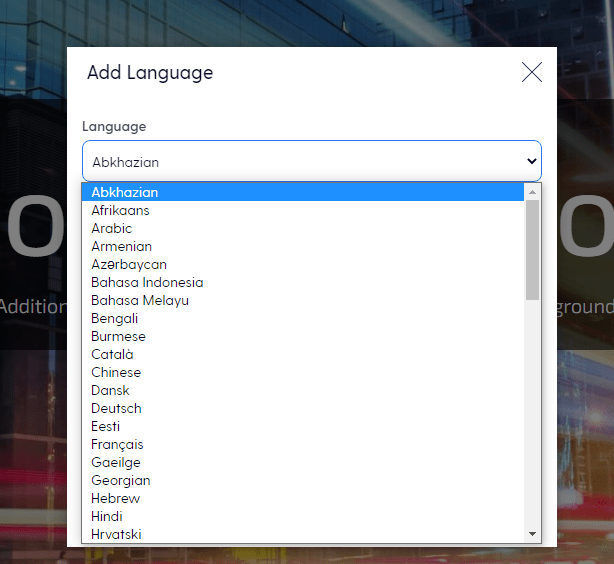
With the free version, you’re limited to two languages for your site, which might constrain some users. That said, you can’t do this at all with any other free website builder. You can use the time you save making sure your translation is on point.
The real payoff for this feature, though, is that visitors will see a button on the top of your site that lets them select which language they want:

It looks extremely polished and professional, to say nothing of how useful it is for people with a global audience. If you choose to use Mozello for an online store, you can duplicate that just as easily. Go ahead, unlock an entire new market for your products.
In terms of design flexibility, you’re fairly wedded to the template you choose. In fact, if you select “Change Layout” in the builder, it will take you back to template selection.
There are a decent range of template options available—48 to be exact—but if you visit enough Mozello sites, you can start to see how the free version is fairly limited. This is reflected in the somewhat lower scores that our users gave Mozello for its ability to make your site your own.
Users raved about how easy it was to use and maintain, but there was noticeably less enthusiasm about how creative you could get.
The helpful thing about the templated design is that it was very easy for first-timers to use Mozello.
“I was totally green” in terms of building a website, one educator told me, but building a website on Mozello proved to be simple for her.
“There [are] pre-made blocks,” she explained, “so if I wanted a long website where I can type a lot, that’s easy. And if I want to add a ‘Contact Me’ form, that was just a click of a button.”
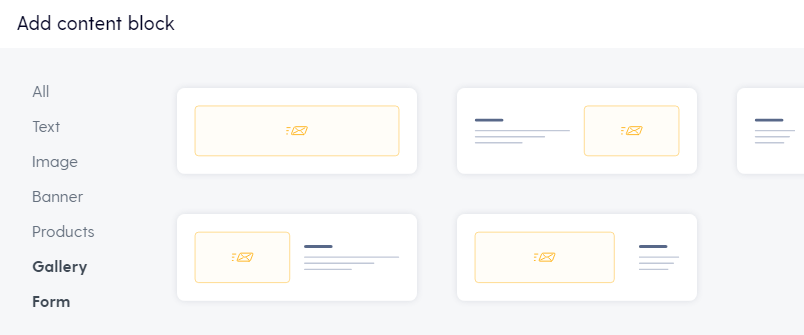
As you can tell from the above image, you really don’t have too many options in terms of layout compared to something like Wix. For a basic website, though, it’s completely fine.
The simple design experience and ease of creating a multilingual website were the two standout features, but there’s a lot more that comes with Mozello. Let’s go through the strengths and drawbacks in more detail.
Building a Free Website with Mozello
While you’re somewhat locked into the template, Mozello does give you a fair amount of room to play with each element on the page.
You have a lot of fonts and colors to choose from. Pick one of the preset color packages for something that looks consistent with little work on your end, or dig in and customize the color of any section:
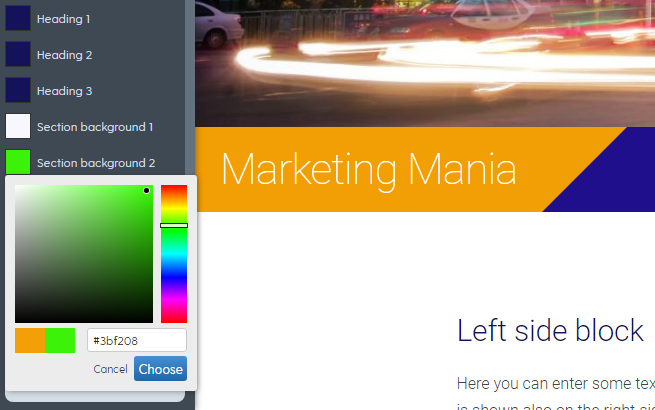
Unlike WordPress, another builder with middling scores for your ability to customize it, you aren’t limited in your color selection based on the template you choose.
It’s more than enough for simple sites. “I had my map in my mind,” one user said, and they were able to get everything the way they wanted in two days. “It was pretty amazing.”
Two days to create a multilingual blog is quite something. And Mozello lets you connect your site to Google Analytics, so you’ll be able to see exactly where your visitors are coming from. This is a great way to improve your marketing—with WordPress, Wix and Square Online, that feature only comes with premium plans.
“I get a lot of viewers from all over the world on my Mozello website,” the educator told me. People wanted to share resources they liked or ask her to post their educational tools on her site. “It’s fascinating, because I’ve had other websites that I put more effort into than the Mozello, but the Mozello [site] is definitely getting the most hits.”
Maybe your company has a website with a paid builder, but you want to take advantage of localization and spin up a multilingual site. With Mozello, you could create a landing page to cast a wider net and start getting real audience data in another language. All for free!
Another feature you don’t get with every free website builder is the ability to sell products from your website.
Mozello lets you sell up to five products with the free plan, and you can accept payments via PayPal or wire transfer. Compared to Square Online, this is fairly limited ecommerce functionality, but the other options don’t let you sell at all on their free forever versions.
None of the users I spoke with took advantage of this feature, but it’s easy to imagine a blogger selling their book or an artist putting a few prints online for sale. Given that you can sell digital products (you just have to check a box in Mozello), it would be possible to offer courses and ebooks in multiple languages for free.
And, of course, Mozello supports multiple currencies and can handle VAT taxes for EU customers.
It’s not enough for a full-fledged online store—Square Online will work much better—but it’s certainly a nice perk that opens doors for the right purpose.
Using the free version, there’s a small footer on the page that reads “Created with Mozello – the world’s easiest to use website builder.” It’s not very obtrusive at all. There are no banner ads, like you get with Wix or GoDaddy.
In fact, one user we talked to was completely unaware of the advertisement at all. “It’s because you mentioned it that I’m aware of it,” he said, “but I had no clue that it was there.”
Like Square Online, Mozello received perfect scores for lack of advertisements. For people that are turned off by ads on free sites from WordPress and Wix, Mozello is another easy-to-use alternative that will be much more palatable.
Cons of Building a Free Website with Mozello
Users had nearly zero complaints about Mozello.
“You can’t really customize it that much,” one user admitted. “It’s possible to change the code, but I haven’t really looked into it that much.”
If you’re in the market for a free website builder, odds are you aren’t interested in coding, so you don’t want to set your artistic expectations super high if you go with Mozello.
For the most part, the users I spoke to were only interested in creating basic websites, so the design limitations weren’t such a big deal.They weren’t trying to do too much, so they were fine with it. Users looking to get creative are going to like Wix a lot more than Mozello.
The user who was documenting their bike trip ran into problems with storage limits. Mozello gives you 500 MB on the free plan, which is similar to other plans on our list. For folks posting a lot of image-heavy content, this might be a concern.
“Towards the end of my trip, I think I downloaded too many pictures,” he said. “I wanted to add an extra 10 pictures [but] I had to upgrade my plan, and I was like, ‘Wow, it’s the end of the trip. Is this worth it? No.’”
This was really his only complaint with Mozello, but in the end, he was able to use the easy image editing tools to work around the problem. “I ended up resizing some of the pictures to make sure that I can upload more,” he said.
Resizing and optimizing images on your website is something you want to be doing, regardless of the website builder you choose. It will keep your site faster and improve your SEO Rankings
Like other free website builders, you can’t have your own domain. This was the reason that the educator chose to upgrade from the free plan. She wanted her name to be the domain without the word Mozello in the URL.
Another user thought about upgrading for the same reason, “because Mozello was just a word that nobody heard before.” It’s a small difference, but having something more recognizable, like Square or GoDaddy, in the URL may be an advantage simply because people have heard of it.
Why We Ranked Mozello at #4
Mozello is a really great website builder for people who just need a basic website. You can’t do as much as you can with GoDaddy and Wix, but for someone who isn’t trying to break the mold, Mozello is going to be all they need.
The upshot of going with Mozello is a lack of advertisements and upsells, which both the aforementioned platforms have. Plus you can launch a free (albeit limited) online store, which is definitely something you’re paying for on most platforms.
Where it stands apart from the crowd is the ability to generate a multilingual site with hardly any trouble at all. In this regard, Mozello is completely unique from every other free site builder we looked at.
Bottom line: Mozello is the perfect site builder for people who need a multilingual site, or folks who are willing to sacrifice a little artistic freedom to avoid ads and upsells.
#5 – WordPress.com – Best for Growing an Audience with Your Site
- Best for blogging & personal projects
- More generous storage (3 GB)
- Block editor
- Readership-building tools
Overall Score: 3.66
Accessibility For Beginners: 4.25
Ability to make it your own: 3.63
Quality of free features and services: 3.75
Unobtrusiveness of advertisements: 3

WordPress is another accessible website builder that’s going to work best for people who want to blog, advocate for a cause, or share their personal project.
When you use WordPress.com, you can have them host your site for free, but you do lose out on a lot of the creative freedom you get with WordPress.org, where you have to pay for hosting.
Still, you get more than enough to get your site off the ground, and far more storage than you get with other builders:
- 3 GB storage
- Unlimited bandwidth
- Blogging
- Audio, galleries, slideshows
- CDN (via Jetpack)
- Subscriber tools
- Community support
We don’t recommend it for businesses, as the WordPress advertisements are more intrusive than any other platform on my list. You have a header/footer ad like GoDaddy and Wix, but you may also get advertisements from third-parties, which is probably not a good idea for establishing a credible business presence online.
But WordPress.com is one of the most popular free website builders on the planet, and for good reason. It’s very easy to use. “WordPress didn’t require any special knowledge to use it for the very first time,” one user told us.
It’s all point and click. WordPress virtually walks you through the process of adding text and images to create new pages and blog posts.
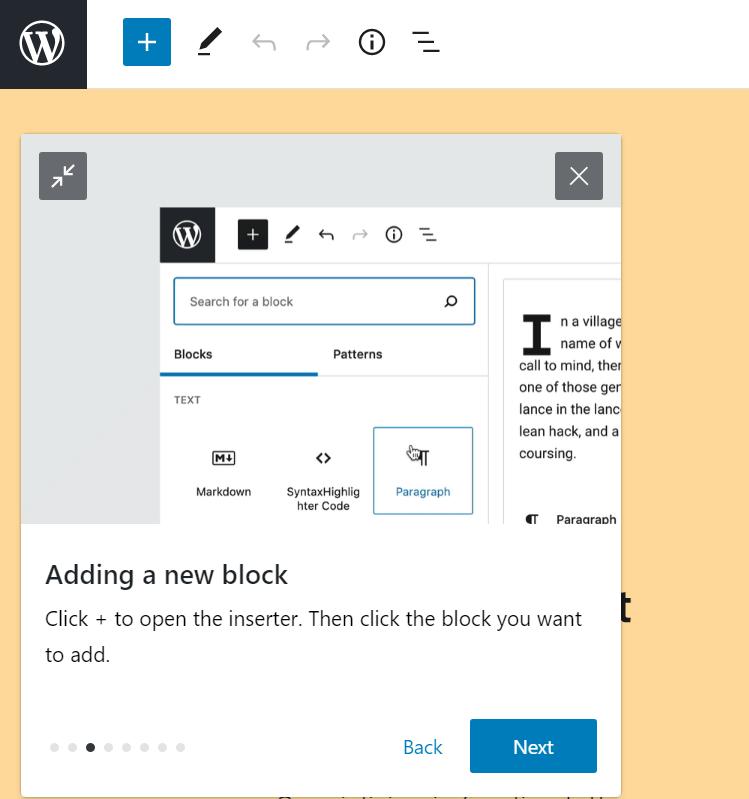
Users felt like the guidance was on point and the interface took very little time to get used to. “The ease of maintenance and ‘building by blocks’ nature of putting together blog posts are both very likeable features of WordPress,” one user noted.
He uses the site to showcase his work in advertising and branding. He said he just browsed the WordPress themes available, found one that he liked, and got to work. “My theme came with a pretty thorough tutorial which really helped in getting the grid layout looking exactly the way I wanted it to.”
WordPress themes are basically the same thing as templates in that they govern the layout of your site. You can only use a limited number of themes with WordPress.com (23, to be exact) and you’re not going to get quite as rich a color palette or as many fonts as Wix. It’s not the site for people looking to make an original artistic statement.
In terms of building a community or growing an audience, however, WordPress has some unique features that separate it from the rest of the pack. Let’s dig a little deeper.
Building a Free Website with WordPress
WordPress is the most template-driven of all the free website builders. Once you lock into a theme, most users aren’t going to be able to “make it their own” to the same extent as other platforms.
As one user said, “Unless you’re doing the coding and stuff, you’re limited by your template.” By template, he’s referring to the WordPress theme that controls your site’s layout. Yes, if you’ve seen hundreds of Wix or GoDaddy sites, you can recognize them pretty quick. But with WordPress, it’s even more challenging to stand out from the crowd.
For some WordPress users, the minimal ability to customize was a downside. They wanted to use a wider variety of colors or the ability to tweak the layout, but they couldn’t.
“A lot of the aesthetic work is just picking a template,” one user explained, “And then after that, you’re like adding all your pictures and text into that template.”
This was a downside to the user, though they recognized that other folks might not mind that at all. The design limitations might even “be a relief” to someone that was new to making websites.
“It’s just more clear cut—there’s not many factors to worry about,” they said. “Although the final product looks nice.”
Once you pick your theme, there are very few backend adjustments you have to do in order to keep your site looking clean and polished. “The more research you put into finding a theme that is tailor-made for your business needs, the more you will get out of WP,” another user advised.
With WordPress, you sacrifice a little artistic license, but it’s really straightforward to build and maintain your site. You are just adding different blocks or patterns to your site. When you go to add a block, WordPress provides a mini-preview of what it will look like:
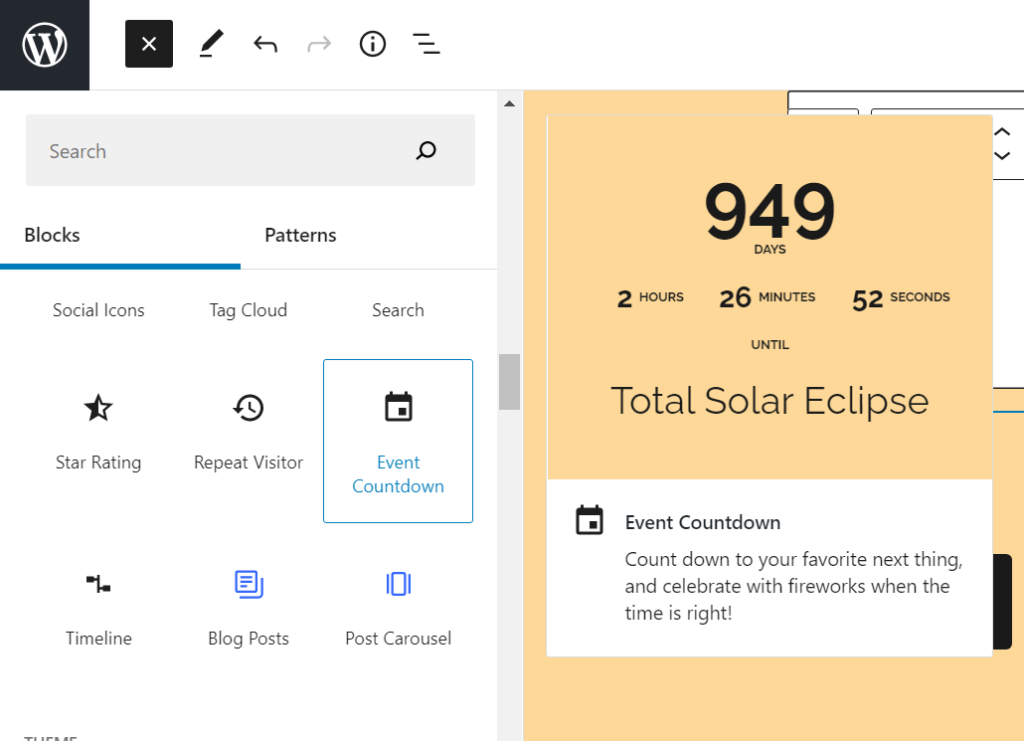
Block options include text, images, galleries, audio, and even simple widgets like the event countdown pictured above.
Although you can’t add videos to your media library without a paid WordPress plan, you do have the option to embed links from YouTube, Vimeo, other multimedia platforms, and social media accounts:
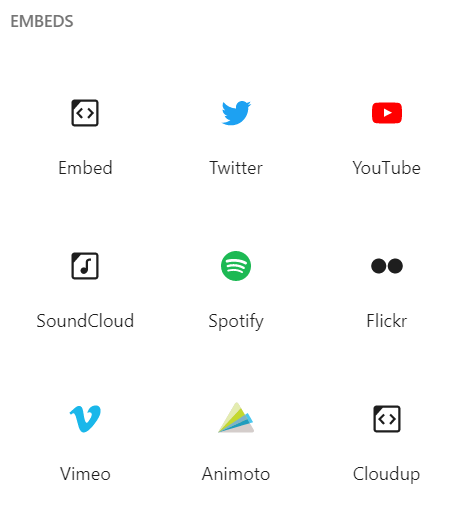
So while you don’t get so much control over the general layout of your site, you can add a lot of different content types to your page.
WordPress is not as “playful” as Wix, according to a user who had sites on both platforms. But if you don’t care so much about the ability to drag and drop page elements or test out a hundred different fonts, you may really appreciate the clear cut design experience in WordPress.
And if you are trying to connect with other like-minded folks, WordPress has tools none of the other platforms have.
We spoke with a poet who used WordPress to share their work and meet other wordsmiths online. While the design constraints didn’t allow them to build the “perfect” site they were hoping for, they still felt that “WordPress provides a friendly environment that an artist requires to popularize his/her work.”
What he means by “friendly environment” is that you can easily follow other WordPress users and they can follow you back. He really liked the WordPress Reader, which generates a completely “custom magazine” for you based on the other WordPress users you follow.
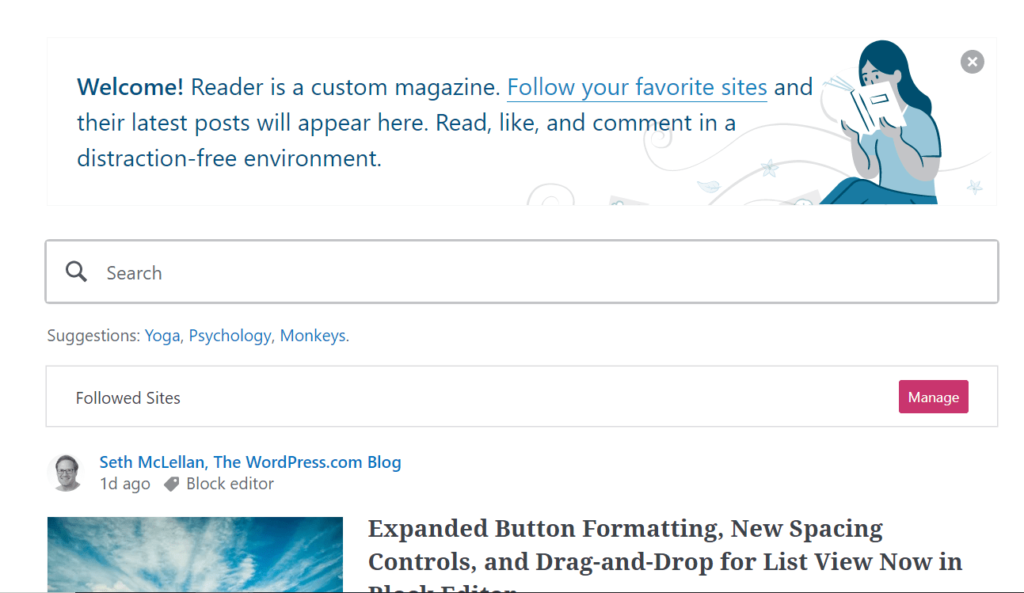
For the poet and other users we interviewed, having the Reader baked into the site was a huge part of how they found success on WordPress. As he said, the Reader, “makes it easier for viewers to read, like and comment on the latest posts from their desired websites.”
You can blog with just about any site builder except Square Online. There, readers can like and comment, but there’s not necessarily a way to follow other blogs or have a custom magazine made from your blogroll.
It was important for the poet not to miss anything from the people he followed, and that new readers could find/follow him just as easily.
“I’ve seen several writers using Wix/Weebly for building their sites,” he said. “They hardly get one comment on their posts.Just look at one WordPress site, you will understand where lies the difference.”
There are other blogging-specific sites that have an audience baked in, like Blogger, but as one user pointed out, WordPress “provides a lot more flexibility.”
Compared to Wix or GoDaddy, WordPress is limited design-wise, sure, but when you start comparing it to other blogging platforms, it’s a lot more customizable.
In terms of creating a community around your site, WordPress is just designed better than any other website builder we looked at.
Another user who built a WordPress site to share news from their research and travels loved the free subscription service that automatically emailed subscribers when she posted something new.
“I know some people use MailChimp and similar services,” she said, “but, for me, WordPress’ functionality was enough.”
It’s not that you can’t set up a subscription service via contact forms with other website builders—you can. It just might not be as simple as it is with WordPress, and you’re not going to get that built-in community.
On the day you launch your site, you’ll immediately be connected to what one user described as “a large audience who are eager to learn, read, write, and share.”
And, since WordPress gives you six times as much storage as every other free website builder we looked at, you can share a lot.
Getting 3 GB of storage is very generous, especially because you will only be able to upload images. You can embed videos on a free WordPress site, but you’ll have to upload them to another site like YouTube or Vimeo.
The high storage limits for WordPress will be attractive to users who post a lot of content. I spoke with one Mozello user who was extremely frustrated by hitting their data limits and had to go back and delete, resize, and reformat images in order to make more space.
Cons of Building a Free Website with WordPress
Beyond the lack of control over the layout, the most noticeable downside to using WordPress for some users was the advertisements. In addition to the header/footer ads promoting WordPress, you may also get third-party ads on your site.
According to WordPress, “The ads your viewers will see are determined by their location, browsing histories, and other factors.”
You’re not going to get any racy or illegal ads—WordPress screens them—but this is the only site builder we looked at that allows third parties to advertise on your website. You have to decide if this is an issue for you, because it’s completely subjective.
One of the users said that she wasn’t bothered by the ads at all and had no reason to think they impacted her site visitors either. The other users were not so thrilled.
It was the “main bugbear” for one and another user noted, “there’s little doubt that advertisements are sometimes irritating to visitors.”
Unsurprisingly to us, the user who liked the ads least was the one using WordPress to promote their business. It’s hard to sell to people when there are other advertisements present.
This is why we highly recommend upgrading your WordPress.com plan if you want to use it for a business, or paying for hosting and using WordPress.org. It’s a small price for a lot more artistic control and zero ads on your site.
The other amazing aspect of WordPress that you miss out on with the free version are the wealth of plugins. These can add a ton of functionality to your site.
“Unfortunately,” one user noted, “you really have to upgrade to the Business plan before being able to install any worthwhile plugins.”
The free version of WordPress does come with Jetpack Essentials, which provides you with a free CDN (content delivery network) which increases your site speed, and some rudimentary SEO tools.
You can’t use a better version of Jetpack, unfortunately, because the SEO features you get with Essentials are limited to creating short links of your site and previewing what your site will look like in social media shares. This is not much at all.
One of the other complaints was that WordPress was not a true WYSIWYG editor.
“It took me a moment to learn that what I saw when I was building my site wasn’t necessarily what visitors would see,” one user explained.
It’s more like you are plugging in content to a template that generates a website than editing the page directly. You may find yourself needing to preview the posts a few times in order to get a sense of what things look like before and after you publish.
Still, WordPress sports a minimal learning curve, even in this regard.
“Once I figured that out, everything was pretty simple, and I built the bulk of my site in an afternoon,” the same user told us. “This was quite literally the first time I ever built anything online.”
What you get with WordPress is a fairly simple way to build content. You’re not getting access to the very best themes and plugins to design your site, and there are going to be advertisements that can be intrusive.
Why We Ranked WordPress at #5
WordPress had the lowest total score of any free website builder we reviewed, which is why it wound up at the end of our list. That said, the fifth-best free website builder in the world is still doing a lot of things right.
You’re going to get a ton more storage than you get with the other platforms—3 GB will let you upload and post a lot of content.
As one user noted, publishing content on his WordPress site has led to a lot of people finding him online.
“I keep getting emailed about that one tutorial over and over and over again,” he said, talking about a post he did on how to use a specific technique in a programming language.
“Put your unusual knowledge on your website or blog,” he advised. WordPress is going to do that very well.
Whether you’re a poet or a programmer, you’ll be able to connect with peers in the WordPress community far easier than you will in other platforms. Bloggers and writers grow their audience. Creators can find others in their niche. The other platforms don’t offer that at all.
Bottom line: WordPress is a great starting point for people looking to build and share a lot of content online.
How We Chose Which Products to Review
We’ve been reviewing website builders of all stripes for a long time on Quick Sprout. When it comes to recommending free website builders, we’re looking for a solution that makes sense for people to actually use for their business or personal project.
For this list, we eliminated all free trial only products. Every website builder on our list is free forever, so once you launch your site, you never have to worry about paying to keep it up.
This narrowed down our list considerably. A lot of the best website builders will let you try them for a little while, but there’s no way to avoid paying in the long-term.
We also want our recommendations to offer the best current guidance. All of our posts are consistently updated to reflect changes in pricing, contract terms, and other aspects of the products.
Weebly, for example, offers a great free website builder we used to recommend highly for ecommerce. It’s still a great product, but the company has been purchased by Square. If you sign up for Weebly today, you’ll have to create a Square account. You can still make a Weebly site, but you’ll only be able to sell a limited number of products, whereas Square sets no limit.
We also used to recommend free website builders that let you create a single page. These are ultra-simple solutions, which were more useful when the process of building a website used to be more complex.
Today, however, you can use products like Wix and GoDaddy to spin up a simple site just as quickly.
We assumed that most of our readers are going to want the ability to organize their site into pages rather than give their visitors one big scrolling experience. If you just need a landing page, Wix will knock it out of the park for you.
Another thing we valued highly during the selection process was the comprehensiveness of the solution. Did a product come with the nuts and bolts you need to run a site in 2021?
At the beginning of each review, you’ll find a bulleted list that lays out exactly what comes with each website builder: how much storage, how much bandwidth, and any key features.
To keep things simple, we haven’t listed features that come with every product on this list. So don’t worry, every option we reviewed comes with:
- Free web hosting: Your site will be hosted on the provider’s servers. There’s nothing to pay, and no IT responsibilities on your end. With the providers I’ve selected, your site will always be accessible for potential customers.
- Visual website designer: If you can use the internet, you can use these website builders. Some are easier than others, but you don’t have to know any computer languages to get started.
- Free SSL certificate: A secure sockets layer (SSL) certificate encrypts information on your site and lets Google know it’s safe for visitors. You do not want Google telling people your page is insecure, especially if it’s an online store.
- Contact forms: With a few clicks, you can add a contact form to your page and start turning site visitors into customers, leads, readers, or enthusiasts of your site.
All of these features are ready to go. You’re not having to authenticate or renew an SSL certificate for your site on your own, for example. To make our list, the fundamentals had to be there.
To narrow our selection down to a final list involved many hours of research. Our team visited hundreds of pages built with free website builders. It was amazing to see how different types of businesses designed their piece of online real estate and how they used it to connect with customers.
In a basic sense, the products we selected were the ones doing the best job for these businesses—the websites were polished, professional, and uniquely connected with their audience.
But how easy are these tools to use? How much did the finished website reflect the original goals of the builder?
These are important questions that can’t be answered by reading the product copy on the vendor website (spoiler: every vendor thinks their product is #1), and reading aggregated review websites can only get you so far.
How We Reviewed Each Free Website Builder
To supplement our research and get a better sense of how these builders worked in practice, we reached out to actual users. These are owners, bloggers, artists, and others who are using these free website builders in order to grow their business.
Using Google search operators, we were able to find users based on their subdomain (wixsite.com, for example) or by the advertising footprint (Proudly created with Wix.com, for example).
The sites we found were not uniformly stunning. It might come as no surprise, we encountered a lot of half-baked, unfinished, and derelict sites. Those we passed by, in favor of sites that were “in business” so to speak. Whether or not they were for commercial purposes, these sites looked sharp and had been recently updated.
We spoke with freelance designers looking to showcase their portfolios. They needed something visually unique they could share with potential clients. There were animators who needed videos embedded in their site, graphic artists who used an online store to sell prints and originals.
More than a few business owners talked about the need to establish an online presence for their brick and mortar. They needed to create a site that fit with their brand, gave customers key information (business hours, shipping rates, new promotions, etc.), and linked to their social media accounts.
Not everyone wanted to share their time, which will surprise no one who’s written cold emails before. But we persevered, and after successfully making contact with the site owner in each case, we confirmed that they used the free version to build their website.
A few of the users had upgraded without purchasing their own domain, but we made sure that they used the free builder to produce the current site we were looking at. We excluded any site that made use of a paid website builder.
In the end, we found three or four users for each platform. Some responded to a survey whereas others hopped on a call for a 15-20 minute interview.
In both cases, we asked the users to talk about their experience with the website builder. In addition to sussing out the pros and cons, we asked them to rank the builders on a one-to-five scale (one being the worst, five being the best) on the following criteria:
- Accessibility for beginners
- Ability to make it your own
- Quality of free features and services
- Unobtrusiveness of advertisements
We’ll walk through each of those criteria in detail below, but our conversations and survey responses touched on a variety of other areas, as well. Several of the people we talked with had used multiple free website builders. They offered frank appraisals about why they switched from one to the other and what each one did better.
Once we had the user data, surveys, and interviews, it was time to rank the products.
Each one received an average score for each criteria based on user reviews, and an overall score from averaging their criteria scores.
These factors weighed heavily in our rankings, but so did the responses from users. At the end of every review, you’ll find a section that takes our findings into account and discusses why we ranked the website builder the way we did.
What We Learned Choosing the Best Free Website Builder
If you are short on funds, there is no reason to pay for a website today.
That was probably our biggest takeaway. It’s so much easier to get a good looking website for free than it was even five years ago. For zero dollars, you can have a professional web presence right now.
Here’s another thing we learned that’s going to sound unhelpful at first: all of the following categories are highly subjective.
We can tell you the hard facts about what each program includes, but your confidence with tech, desire to express your creativity, and marketing goals are going to have a huge impact on how you view those facts.
For each criteria, there’s a discussion of why it’s important, followed by guidance on how to position yourself with respect to the category.
Accessibility for Beginners
We assumed that many people searching for a free website builder wouldn’t have a ton of web development experience. This turned out to be true as more than half the users we talked to had never built a website before.
In terms of weighting the criteria to make our final ranking, accessibility was very important to us. Who cares about the customization or advertisements if it’s too hard to even get a site built?
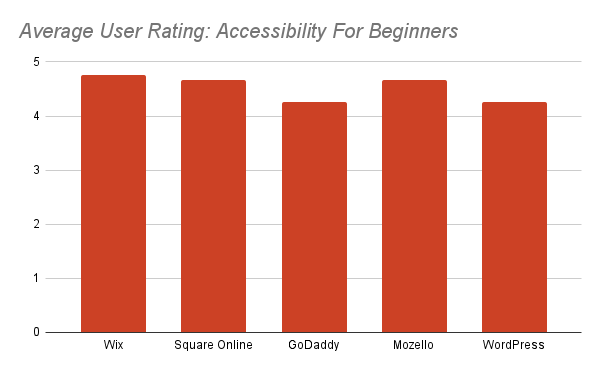
Wix was the highest ranked solution in terms of its accessibility to beginners, slightly edging out Square Online and Mozello. GoDaddy and WordPress received slightly lower scores.
No product received low ratings in this regard, but users couldn’t say enough about how simple the Wix platform was to use, and how quickly they built their site. One business owner told us she built her first site with Wix the same day she found out she needed one.
Even the more seasoned folks were grateful for accessible platforms.
As a video game designer who used WordPress to show off his independent work said, “If you’re an artist trying to get into the game industry, you should be spending your time learning how to make 3D models instead of building websites.”
The speed with which people could build and edit their site was extremely important to users.
“As an entrepreneur or a small business owner, I don’t have the time to spend developing my own website,” one user told us. “And I don’t honestly want to spend the money to hire someone to do it.”
Using Square Online, he can sell products in person or online with a site that’s simple enough for him to maintain by himself.
Many users pointed out the need to make changes to the website themselves—updating information, running promotions, removing out-of-stock items. They don’t want to pay someone to build it and then pay them again to make changes.
One woman who used GoDaddy explained how easy it was to create popups on her site during registration periods for her dance academy. She’d never built a website before, and her work as a teacher using software for her school system was all the prior experience she needed to use GoDaddy’s free plan for all it was worth.
Square Online also received very high accessibility ratings, which is impressive given that these users had online stores and took payments. The whole process remained easy despite the fact their online stores were much more complex than most of the sites I saw on other free platforms.
WordPress received the lowest rating in the category, most likely because it is much more of a traditional website design interface than the other platforms. It’s not too complicated, but there is something of a learning curve to get things laid out on the page the way you envision.
It’s not true WYSIWYG, so the way it looks in the template is a little different from what you see after publishing the page.
With the other editors, there may be small differences between the site pre and post publication, but they are not quite as pronounced as what you see with WordPress.
This isn’t to say WordPress is hard, and one first-time website builder I spoke with said that, despite some initial difficulties, she still managed to build her site that afternoon.
In fact one user who had sites on both platforms thought that WordPress might be even more accessible than Wix to people who didn’t want so many options.
“If you’re my grandma, who doesn’t use computers at all,” he said, volunteering an example, the limitations of the platform were a relief. Whereas the same type of user tries Wix, he said, “and they don’t really use it well. They’ll end up with something really jacked up looking.”
It comes down to the question of “What’s a beginner?” Someone who’s comfortable experimenting and learning is going to be fine with Wix. Yet someone who is less confident with technology may find the rigidity of WordPress a little easier to work with.
Ability to Make It Your Own
To some extent, you’re stuck within a template using free website builders. If you know HTML and CSS, you may have a little more freedom. But for the purposes of this review, I’m assuming most of you would be happier with a free site builder that you never have to touch the code in.
So while it’s possible in some cases to get crafty with the code, none of the customization and personalization we’re talking about in this category requires it.
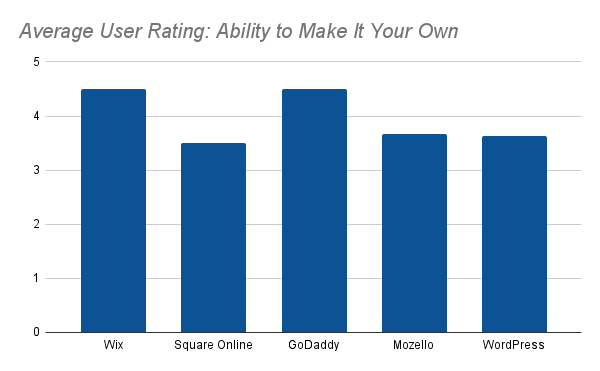
Wix and GoDaddy were the clear winners in this category, which is what we expected.
After visiting hundreds of sites from every provider, we could immediately recognize sites made with Square, Mozello, and definitely WordPress. With GoDaddy and Wix, it was a little harder to know, though neither free platform lets creators truly escape their templates.
Users wanted their sites to align with their brand or artwork. “One of my frustrations with WordPress,” one user said, “is that I can only pick so many colors. Maybe it was just the theme I was using.”
It was one of the reasons they ended up building a new site on Wix. “I didn’t have that problem. Wix just gives you the colors.”
Colors and fonts are really important to capturing the feel of your site. If you’ve ever been to a site where the font isn’t working with the content, you know. One GoDaddy user really appreciated the design tools. She said, “I was able to easily incorporate our shop colors in the site layout, which helped create a more uniform look across all pages.”
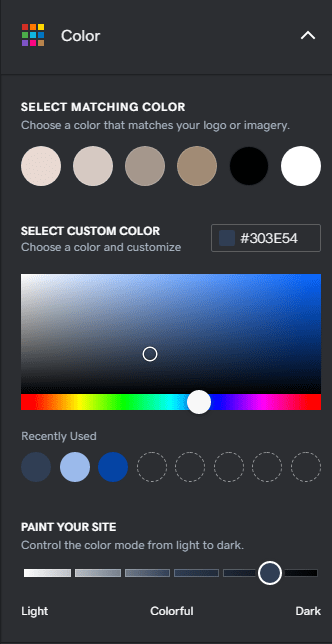
Mozello sites can look great, and they’ll cover your basic needs as well as anyone else. There’s just not a ton you can do to get your site.
One user who had a site with GoDaddy as well Mozello said they were comparable in terms of how easy they were to use, but it was much harder to customize her site with Mozello. WordPress is a similar situation.
“A lot of the aesthetic work is just picking a template,” said one user, talking about the WordPress themes that govern the layout of your site. “After that, you’re just adding all your pictures and text into that template.”
The same user compared his experience with Wix. “Pretty much the page is a canvas,” he said. “You can just slap whatever you want on there, rotate it, scale it.”
This is one of the reasons we ranked Wix number one—it was the most accessible platform and it gave users the most freedom to create. It’s a tough balance to strike, but Wix managed it.
Premium versions of Square give you many more tools to design your site.
“If you’re using the free plan like me, you might have to get a little creative in order to make your site stand out,” said a graphic artist about their online store. Some of the examples she gave were putting graphics where product photos could go or inserting “banners” that were images instead of text.
That said, most Square Online users are taking advantage of the free ecommerce features. Designing a unique site took a backseat to having a functional online store. A little sacrifice on artistic license was well worth the limited ability to customize the layout.
For people looking to get really crafty with their website, a high score in this category will be really important. If you’re not too concerned about personalizing your site, you might find more success using a more clear-cut platform like Mozello or WordPress.
Quality of Free Features and Services
In addition to a website builder, what else are you getting that will help you accomplish your online objectives?
I’ve already mentioned some of the freebies that come with every platform we reviewed, such as contact forms and SSL certificates, but you get a different suite of tools and services with every option.
Some users felt like everything they needed to connect with customers and realize their business goals was built into the platform. Others, it seemed, had to get scrappy in order to use the site they’d built.
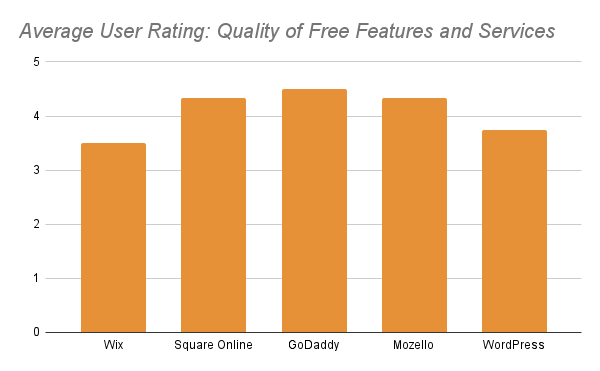
GoDaddy received the highest score in this category, with Mozello and Square Online close behind. GoDaddy users cited the ease of connecting their business to Google and social media accounts as being really important.
Mozello users consistently cited the ability to generate multilingual websites or connect their site to Google Analytics, which requires a paid plan with other site builders. Yes, they had to write the translations of both sites, but the act of duplicating them and giving site visitors a clear button to choose their desired language was the number one reason they went with Mozello.
“I’m pretty sure that a lot of people are creating two sites,” said one Mozello user, talking about the extra work it typically takes to serve readers in multiple languages. He said Mozello’s multilingual site feature is “so easy to use” and described the experience of offering readers a simple button as “magical.”
For Square Online, the users were thrilled by the fact that they could run their online store for free, and that it was synced to their in-person payments as well.
“I could see how some people might need to pay for additional parts in order for their business to work,” said the owner of a microbrewery. “But we don’t.”
Really, unless you need the calculated shipping rates feature, you are getting most of what you need with the free version.
Of course you have to pay Square to process payments, but nobody thought of that as a downside—you are always going to have charges for processing payments.
Wix received the lowest score in this category, which was a surprise to us. It has many of the same features as GoDaddy, which took the number one spot in this category.
It seemed that users were constantly exploring workarounds in order to get more out of the platform.
Multiple people wanted a free online store (available on premium Wix plans only) and had to figure out how to link Square to their Wix site. It wasn’t as straightforward as it could have been, likely because Wix wants you to use their paid online store.
It just goes to show how excellent Wix website builder is—people who want an online store can use Square, but for these users, Wix made enough of a better website than Square to justify the extra work of linking two sites.
WordPress also had lower scores in this category, likely because you can’t use all of the amazing plugins and themes that are available to WordPress.org users. With the limited selection available to free WordPress.com users, it was harder to get their site to be more than a blog.
Unobtrusiveness of advertisements
Providers put their brand and advertisements on free websites. It’s how they pay the bills, and how you avoid paying one yourself. While you can’t get rid of ads completely on a complimentary website, providers vary in how they brand your site and the types of ads they run.
So, you have some control and it’s important to think about this before you decide.
On some sites, the advertising footprint is pretty minimal, and the users didn’t think much of it—with other sites, the users had a lot more to say about how the ads impacted their experience.
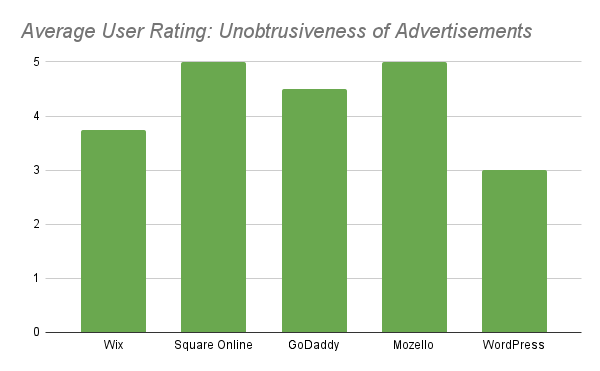
There were few surprises in the overall results. The platforms with the least amount of advertising, Square Online and Mozello, got perfect scores in this category. Those with more overt methods scored lower.
One thing that did stick out to us was the nearly full point difference between Wix and GoDaddy. As far as we could tell, these two left the same advertising footprint on free sites. And neither provider is shy about making upsells, which is basically advertising directly to you.
It’s not just ads, and by looking at the whole picture, you can see where the scores come from. Lets walk through each of the ways that free website builders promote their product on your site.
First off, the provider’s name is going to show up in your web address. This is because you can’t use your own domain with free sites, you have to use a subdomain of the provider. Here’s how your site’s URL looks for each provider:
- Wix: [youraccount].wixsite.com/[yoursite]
- Square: [yoursite].square.site
- GoDaddy: [yoursite].godaddysites.com
- Mozello: [yoursite].mozello.com
- WordPress: [yoursite].wordpress.com
Almost everyone I talked to was not a fan of the longer URL. It doesn’t look as great on a business card as having your own domain, but it’s the price of a free website builder.
Wix has the most cumbersome URL, which was something everyone on the platform brought up.
“It’s pretty wonky,” one Wix user said, “You can have fun with [the Wix] website builder, but if you want to make it a professional thing, you pay to make your domain look good.”
It’s no different for the other sites, but the sheer size of the Wix URL is something people definitely noticed.
And then there are the ads that run on your site. WordPress is the only one that allows third-party ads, and it showed in the user rankings. The other platforms run a header ad, a footer ad, or both.
Wix, WordPress, and GoDaddy run slim headers at the top of the website

They also run footers at the bottom.

No one likes these ads, but users tolerated them.
“It’s not too bulky and doesn’t interfere with navigating the website,” one Wix user shared, “but it does make the website feel a little bit cheaper.”
If you want to minimize the number of ads, I suggest Mozello and Square, as they are limited to a discrete footer that blends in with the site design.
This is one reason why those companies received such high scores in this category—no banner ads at the top of the page.
Many of the people I interviewed about Square and Mozello forgot that the footers were there until I brought it up. More than one initially told us that they didn’t know about the ads on their site at all.
If you don’t mind advertisements, Wix and GoDaddy are going to give you the best website builder you can get for free. If you do mind ads, Mozello is going to be the most appealing, or just go with Square Online if you need an online store.
Conclusion
There’s no need to shell out a bunch of cash if you want to build a website. If you have ever purchased an online service before, you know that costs can climb. You start out paying a little and somehow, as if by magic, you wind up paying twice or three times as much a few bills down the line.
With the best free website builders, you never even have to take out a credit card. Here are my top five recommendations:
- Wix – Best for creating a polished site this evening
- Square Online – Best for building a free online store
- GoDaddy – Best for businesses that don’t need an online store
- Mozello – Best for building a multilingual site
- WordPress.com – Best for growing an audience with your site
The top pick, Wix, is definitely the product I think most users are going to love. The website builder is modern, flexible, and gives you a huge range of options to make a bold impression with your site.
If you’re trying to start an online store, though, Wix isn’t going to be free. Use Square Online instead to start making online sales for free. Unlimited items, built-in metrics to track your sales, and an uber-simple design interface make this option a no-brainer for folks looking to get into ecommerce.
GoDaddy is another solid website builder, especially if you are trying to establish a business presence online. You can’t have an online store, but there’s a lot more flexibility to design than Square and many helpful features to grow your customer base.
Mozello is the simple solution for people that need a site in more than one language. No other free platform offers such an easy way to create a multilingual website. The lack of advertisements and upsells will also be welcome to users that are turned off by promoting other folks’ products on their site.
WordPress is my top choice for people looking to find like-minded users, build a community, or grow an audience of loyal readers. It provides a much more flexible website building experience compared to other blogging platforms (think Blogger and Medium), even if it’s somewhat constraining with regards to other website builders.
Do you use a free website builder I didn’t cover?




